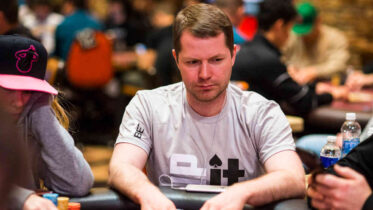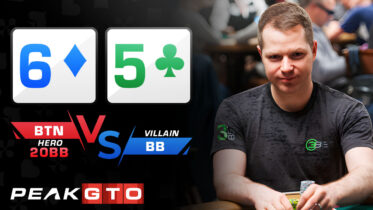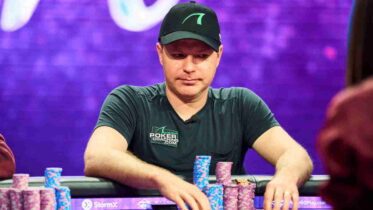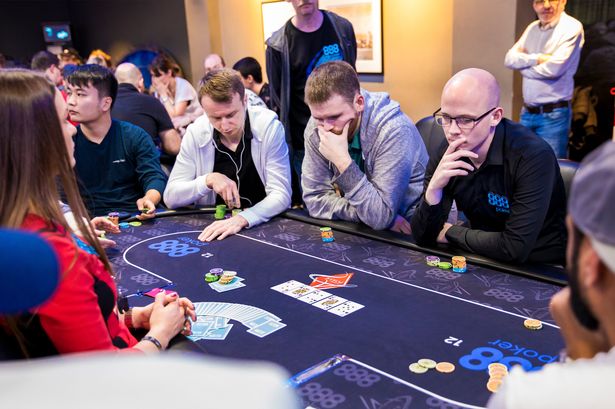Losing is a part of poker, whether you are the best player in the world or a recreational player who plays the game occasionally with their friends.
If you have never gone through a bad stretch playing poker, you simply haven’t played long enough, and you are in for a nasty surprise if you don’t get ready.
The game of poker is riddled with variance, and both upswings and downswings are unavoidable for all of us. For that reason, knowing how to limit your downswings and cope with them is of key importance.
In this article, we will aim to explain the phenomenon of poker downswings and the best ways to handle them when they do come along.
What Is a Downswing in Poker?
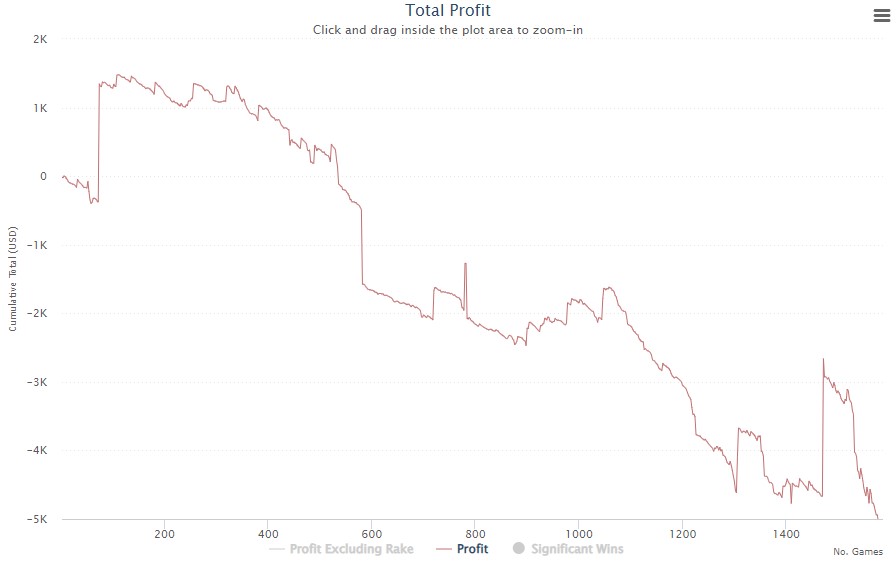
Poker players use the word downswing to describe different things, but generally speaking, the term refers to a prolonged period of losing money at the poker tables.
The exact amount of money lost and the duration of a poker downswing can differ wildly from one case to another. The thing they all have in common is that they have the potential to ruin even the best of players mentally.
Before you start playing poker with any degree of seriousness, you need to understand you will experience some downswings, so the most important thing is to be able to identify them.
Let’s start by identifying what a poker downswing might look like in different game formats.
Identifying a Poker Downswing
Many players I have personally encountered over the years start moaning about a downswing as soon as they have two consecutive losing sessions, but that’s not the definition of a downswing.
Regardless of the game format you play, losing sessions in poker are inevitable. The more variance-heavy your format is, the more likely you are to encounter them. Thus, you should only be worried about a downswing when you experience a prolonged set of losing sessions in a relatively short period of time.
For instance, if you play live cash games as a big favorite, you can expect to win quite often. Losing five or six times in a row can be considered a downswing in such a game, while losing 20 buyins over a couple of weeks of play is also definitely a downswing.
On the other hand, losing 20 buyins in big field online tournaments is routine, and you should not pay any attention to it.
For this exact reason, professional poker players make sure to identify the game type they are playing and the likelihood of encountering certain downswings before they start playing. This helps them plan out their bankroll management ahead of time.
But how can you plan for downswings and know what’s possible and likely? Let’s find out!
Planning for Downswings
Bankroll management is one of the most important yet most underestimated skills that a professional poker player must master.
Even many players whose overall skillset is quite solid encounter problems with bankroll management because they underestimate the likelihood of downswings.
Using a simple poker variance calculator, it is possible to calculate the likelihood of running into a downswing of a certain magnitude using the following information:
- Average buyin
- Number of games played
- Win rate/ROI
- Average field size (in tournaments)
Once you enter all this information into a variance calculator, the calculator will tell you how likely you are to lose a bankroll of a certain size.
The hardest part of entering this information is calculating the correct win rate or ROI you have in the games you plan to play.
So, if you don’t have enough information from previous games, aim for a low number and try to create a bankroll that will not get demolished, even if you are only winning at a low win rate.
If you play a certain number of games and see that you are crushing the games at a significantly higher rate, you may be able to update those numbers or move up the stakes rather quickly.
Dealing with Downswings
If you have used the variance calculator properly and done all the necessary preparation, you will have the bankroll to sustain even some nasty downswings.
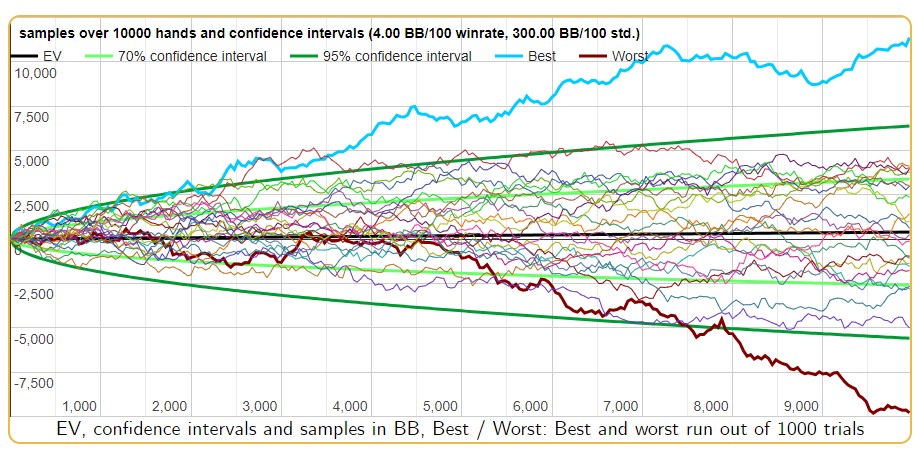
And yet, even if you have the appropriate bankroll, encountering a downswing in real life will not be a pleasant feeling.
Many times, poker players allow downswings to completely ruin their motivation and their self-confidence, making them question every decision they make.
However, this is not the right approach to take. If you know downswings are coming sooner or later, encountering them should become routine.
The way to tackle a downswing is head-on! Keep playing your game without hesitation, and don’t deviate from the decisions you would normally make.
Regardless of how many times in a row you shove into the nuts, keep doing it if your study sessions have shown it to be a profitable play.
Remember, every play in poker will go wrong sometimes, and you will lose many pots in any given session, holding both bluffs and second-best value hands.
Instead of quitting the game or throwing your bankroll away at the blackjack tables, focus on playing good poker, and the results will balance out over time.
How Long Does a Poker Downswing Last?
This is one of the most common questions players ask in regard to poker downswings, but it is one that can’t really be answered easily.
The severity of a downswing will depend on the game type you are playing, the amount of volume you put in, and your win rate in the game.
For instance, in soft live cash games where you are a big winner, the downswing won’t last too many hands. However, you will only be playing some 30 hands per hour, which can still make a downswing last quite a few hours.
On the other hand, in higher-stakes online tournaments, where the edges are much closer, even the best players run into long downswings and lose money over hundreds or even a thousand games.
You should not focus too much on when a downswing will end or even worry about it starting in the first place. Instead, focus on making the right plays, and all the upswings and downswings will even out at the end of the day.
Steps to Take During a Downswing
While encountering a downswing can be just a part of the routine for the most experienced poker players out there, for many of us, downswing can be mentally exhausting.
If you find yourself in the midst of a downswing and can’t quite seem to keep playing your best game, there are steps you can take instead of playing through it.
These include:
- Playing lower stakes
- Studying poker
- Taking time off

One of the first steps to tackle a downswing, when it gets severe, is to move down in stakes and play in games where your bankroll is much safer.
While playing lower stakes will limit your ability to recuperate your losses, it will also allow you to regain your confidence in games that should be softer on average.
If you don’t feel like playing at all, taking time away from the poker tables is also a good idea. Engage in other fun activities, preferably outdoors, and forget about the game for a while.
When you get back to it, sit at your computer and do some studying. Review your own sessions and look for leaks in your game instead of jumping right back into the action.
Studying poker is a great way to regain perspective, and if you get the right resources, you could also find new ways to win more in future sessions.
Only get back to playing when you are mentally in a good place, well-rested, and not thinking about all the ways you lost pots the last time you played the game.
Final Words on Poker Downswings
The most important thing to remember when it comes to poker downswings is that they happen to everyone and that no poker player is immune to them.
Whether you play at the highest stakes at the Las Vegas casinos or micro stakes in your friend’s garage, you will run into a downswing sooner or later.
When your next downswing comes along, ensure you have the bankroll to sustain it, the tools needed to tackle it, and the willingness to take the appropriate steps to get out of it.
If you play poker long enough, downswings will become a part of the routine, and you will get to a place where you no longer pay too much attention to the results of your plays but rather to how you play your hands and counter your opponents’ tendencies.


